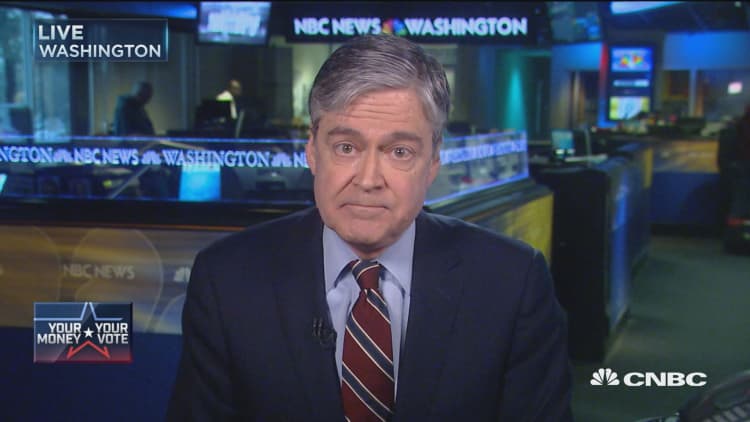


As Ohio voters cast ballots in Tuesday's presidential primary, the economy — specifically manufacturing jobs — will be front and center on many voters' minds.
"We have to have a strong manufacturing base for this country to survive," said Brandon Lamoncha, sales manager and solution provider at Humtown, a third-generation, family owned manufacturer in Columbiana, Ohio. "I have to vote later today and I'm still undecided. I really don't know," said Lamoncha, who is a registered Republican and has supported Gov. John Kasich in past local races.
And it is precisely this wariness about the state's economic prospects that Donald Trump has mined. The contest in the Buckeye State is crucial, as a victory by Kasich could stall Trump's march to secure a majority of delegates needed for his party's nomination.
Ohio is among five states holding primary elections Tuesday along with Florida, Illinois, Missouri and North Carolina.
Lamoncha and other regional manufacturers have worked hard to anchor jobs in the area despite offshoring trends and lower wages in China and elsewhere. "Our customer base has shrunk almost 50 percent since my grandfather founded the company" in a garage in 1959, he said.
The region's decline in manufacturing work has been in step with national trends. U.S. manufacturing employment has trended downward since 1980, and those job losses have been especially severe during the past decade. Between 2000 and 2009, the nation lost 31.2 percent of its manufacturing jobs, and the sector fell from 13.1 percent of total employment to 9.1 percent, as noted in an American manufacturing report co-authored by Susan Helper, a professor of economics at Case Western Reserve University in Ohio.
The nation's manufacturing output grew by only 11 percent during the same period, while GDP increased by 15.7 percent. As a result, manufacturing's share of GDP fell from 14.2 percent to 11 percent.
Not surprisingly, manufacturing job declines have been especially severe in the Great Lakes region, where auto assembly and parts manufacturing underpin much of the local economies. Manufacturing employment fell by a greater percentage in Michigan, Ohio, Indiana and Illinois than nationwide between 2000 and 2009, according to Helper's research.
Broadly Ohio's employment numbers peaked around 2000 with a little more than 5.6 million jobs — and have not recovered to those levels, according to the Ohio Department of Job and Family Services.
But unemployment in the state was at 4.9 percent in January, in line with the national rate, as workers have shifted to jobs in nonmanufacturing sectors like education, health service, professional and business services, and leisure and hospitality over time.
"We've been through two or three of the worst economic downturns," said Lamoncha, reflecting on his company's history.
Humtown specializes in metal cast parts that end up in many consumer-facing applications. Think parts for cars, trucks and airplanes including engine blocks and household fixtures like door handles. The company during the last recession was reduced to a dozen employees from around 200 workers.
Metal parts traditionally have been made with conventional tooling methods. Now with computers and additive manufacturing techniques, the metal parts process can be quicker and cheaper, given fewer upfront costs. Plus, metal parts and related tools can literally be made to order.
Humtown, which now employs about 65 workers, began incorporating additive manufacturing about five years ago. "We can be an agile supply chain now to our clients," said Lamoncha. "We've always had to adapt."
The company got support for its push into new technology from the Youngstown Business Incubator.
Sprawled across 110,000 square feet and four buildings, the incubator is on Federal Street, Youngstown's Main Street. The incubator includes 30 companies that span business software, information technology and a growing portfolio of additive manufacturing companies.
Roughly 150 jobs have been created since the incubator's launch, said Barb Ewing, chief operating officer of the incubator. Up to 100 more jobs are anticipated, when a new building comes online later this year, she said.
So when Lamoncha heads to the polls, his deciding factor will be manufacturing's future.
"That will be on the forefront, whoever stands on creating jobs and keeping jobs here in North America," he said.
It's worth noting manufacturing is important beyond the industry. A single manufacturing job also generates another 2.5 new jobs in local goods and services, according to Deloitte data. And it's this ripple effect of business activity and jobs growth that Ohio business owners want.
Over the weekend, Hillary Clinton spoke at a Youngstown factory and vowed to end steel-dumping practices by China and other nations. "I have always been committed to bringing back manufacturing," she said. "And I'm the only candidate, on either side, who actually has a plan to do that."
Free trade policies are important to many in Ohio, and Bernie Sanders hopes to capitalize on that sentiment along with a broader message of economic equality and fighting corporate power.
Kasich, meanwhile, has stumped on a narrative about the state's comeback, balancing the budget and putting Ohio back on firmer financial footing after the recession.
Trump, in turn, has zeroed in on Kasich's free trade policies, which the billionaire says have hurt Ohio's economy and jobs market.
No matter how each candidate slices it, voter priorities straddle job creation and supporting Ohio's fundamental manufacturing base.
"It has been really hard to survive in this economic climate," said Lamoncha of Humtown. "Our biggest thing is the manufacturing base needs to be strong for us to survive."





